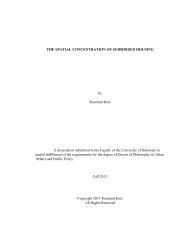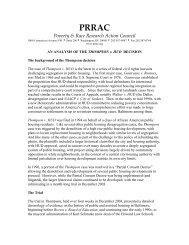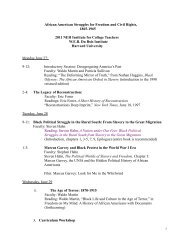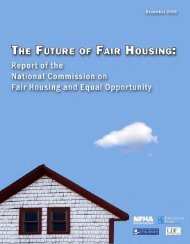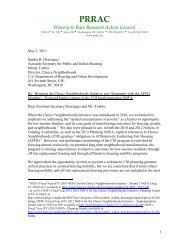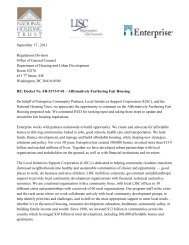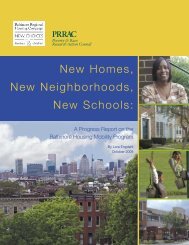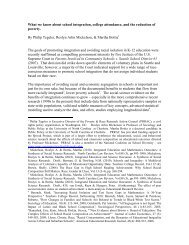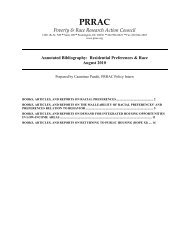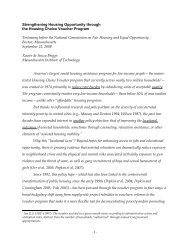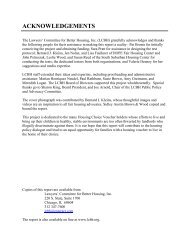Annotated Bibliography of Housing Mobility Research 2006-2010
Annotated Bibliography of Housing Mobility Research 2006-2010
Annotated Bibliography of Housing Mobility Research 2006-2010
Create successful ePaper yourself
Turn your PDF publications into a flip-book with our unique Google optimized e-Paper software.
Books, Articles, and Reports on <strong>Housing</strong> <strong>Mobility</strong><br />
Abt Associates Inc. et al., “Effects <strong>of</strong> <strong>Housing</strong> Vouchers on Welfare Families,” prepared for<br />
U.S. Department <strong>of</strong> <strong>Housing</strong> & Urban Development (September <strong>2006</strong>). Available at:<br />
http://www.huduser.org/portal/publications/commdevl/hsgvouchers.html<br />
Abstract:<br />
Presents the final analysis <strong>of</strong> a study conducted over several years to measure the impacts <strong>of</strong><br />
<strong>Housing</strong> Choice Vouchers on the housing mobility <strong>of</strong> lowincome families, the characteristics <strong>of</strong><br />
their neighborhoods, the composition <strong>of</strong> their households, their employment, earnings,<br />
participation in education and training, their receipt <strong>of</strong> public assistance, their poverty and material<br />
hardship, and the wellbeing <strong>of</strong> their children. The analysis, based on a sixsite research sample <strong>of</strong><br />
8,731 families, uses an experimental design and makes use <strong>of</strong> outcome measures derived from<br />
tractlevel Census data, personlevel administrative data, and a followup survey. The impact<br />
estimates in this report encompass a followup period that is sixteen quarters in duration for all<br />
sites, and longer for some sites. Augmenting the experimental findings are insights from intensive<br />
interviews with a sample <strong>of</strong> 141 families. This research was undertaken to evaluate the Welfare to<br />
Work Voucher (WtWV) program, initiated in Fiscal Year 1999 when Congress appropriated $283<br />
million for tenantbased rental assistance to help families to make the transition from welfare to<br />
work. This appropriation funded 50,000 new rental assistance vouchers (P.L. 105276). The U.S.<br />
Department <strong>of</strong> <strong>Housing</strong> and Urban Development (HUD) awarded these vouchers to local and state<br />
housing agencies (HAs) that presented reasonable plans for matching up eligible families with the<br />
available housing assistance and for coordinating these efforts with existing welfare reform and<br />
welfaretowork efforts.<br />
AcevedoGarcia, Dolores, Theresa L. Osypuk, Nancy McArdle & David R. Williams, “Toward<br />
A PolicyRelevant Analysis Of Geographic And Racial/Ethnic Disparities In Child Health,”<br />
Health Affairs, 27(2): 321333 (2008).<br />
Abstract:<br />
Discusses the impact <strong>of</strong> residential segregation on child health outcomes. Argues that the fact that<br />
health disparities are rooted in social factors should not have a paralyzing effect on the public<br />
health community. Highlights the need to move beyond conventional public health and health care<br />
approaches to consider policies to improve access to opportunityrich neighborhoods through<br />
enhanced housing mobility, and to increase the opportunities for healthy living in disadvantaged<br />
neighborhoods. Proposed a policy framework for addressing unequal geography <strong>of</strong> opportunity in<br />
child health.<br />
Boston, Thomas D., “The Effects <strong>of</strong> MixedIncome Revitalization and Residential <strong>Mobility</strong> on<br />
Public <strong>Housing</strong> Residents: A Case Study <strong>of</strong> the Atlanta <strong>Housing</strong> Authority,” Journal <strong>of</strong> the<br />
American Planning Association 71(4): 119 (2005)<br />
Abstract:<br />
An empirical study <strong>of</strong> the effects <strong>of</strong> HOPE VI revitalization on public housing residents, this<br />
article uses administrative data to examine the longterm socioeconomic status <strong>of</strong> households that<br />
relocated from public housing projects in Atlanta as a result <strong>of</strong> mixedincome revitalization.<br />
Comparing residents who lived in three public housing projects that were revitalized to a control<br />
group <strong>of</strong> residents who lived in three projects that were not revitalized, the article shows that<br />
mixedincome revitalization greatly accelerated the residential mobility <strong>of</strong> public housing residents<br />
and that households displaced by revitalization did not experience a statistically significant loss <strong>of</strong><br />
housing assistance. Households that relocated by using vouchers or by moving to mixedincome<br />
revitalized communities experienced significant improvements in their socioeconomic status, and<br />
2



